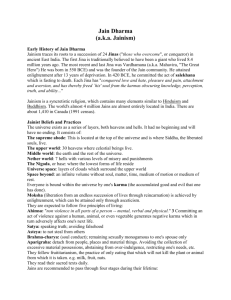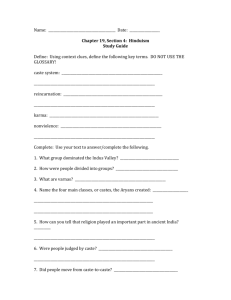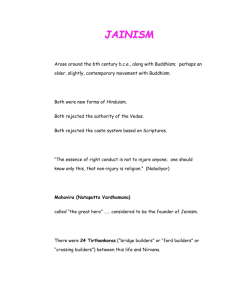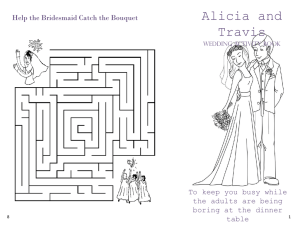Jainism
advertisement
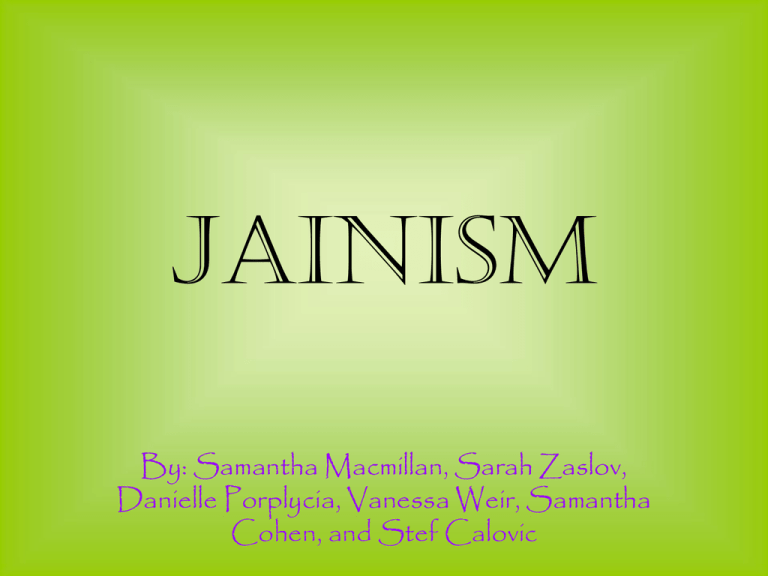
Jainism By: Samantha Macmillan, Sarah Zaslov, Danielle Porplycia, Vanessa Weir, Samantha Cohen, and Stef Calovic Traditions, Rituals, and Ceremonies Sarah Zaslov Pre Wedding Ceremonies… Vagdana/Pradana: Vagdana refers to the informal agreement between the parents of the prospective bride and groom regarding their marriage that is followed by the ritual of Pradana where the bride is gifted ornaments. Laghana Lekhan: The Laghana Lekhan ritual involves a puja held at the girl's house during which the auspicious time of the marriage is determined. Sagai and Lagna Patrika Vachan: It refers to the engagement ceremony where the groom performs the Vinayakyantra puja. And he is gifted with a gold chain, a ring, clothes, coconut, sweets and money. Matruka Sthapan/Kulkar Sthapan: Matruka Stapan/ Kulkar Sthapan are prayer sessions held in the bride/ groom's homes respectively to seek the blessings of the heavenly bodies to ensure the happiness and the fertility of the couple. Mandapa-Vedi Pratishtha: It refers to the construction of the mandap at the bride's home from where it is usuallu transported to the marriage venue. Wedding Day Rituals… Ghudhchadi : Before the barat procession begins, all the ladies of the house, including the groom's mother apply tilak to his forehead after giving him a headgear. Torana Vidhi : Torana Vidhi are the rites of welcome performed for the reception of the groom at the marriage venue. After being garlanded by the bride, he enter the mandap stepping over two earthenware bowls. Kanyavaran : The father of the bride publicly presents his daughter to the groom while the priest pours water on the hands of the bride and groom while chanting a mantra three times during the Kanyavaran ceremony. Hasta Melap : Jhasta Melap involves the placing of a single cloth garland around the couple's necks after which the bride's parents wash the groom's feet, wipe them, dress them with flowers and places auspicious items such as sandalwood in his hands. The priest then places the bride's hand into the groom while reciting the auspicious prayer of Aum Arham. Toran Pratishtha : The Toran Pratishtha ceremony is held in the honour of Goddess Lakshmi, where the bride's parents throw a mixture of sandalwood, rice, and flowers on the arch of the mandap, the Toran. Gotrachar : Gotrachar ritual involves the priest stating the ancestral lineage on the groom and the bride. The couple is then given rice, flowers, incense and mithai (sweets) to offer to the Fire God in a Puja. Agni Pradakshina : The bride's brother gives the couple handfuls of rice that they alternately give to the priest as they pass. The priest offers the rice into the fire. Specific mantras are spoken for each round. More Wedding Day Rituals… Granthi Bandhan : Granthi Bandhan takes place when the bride's sari is tied to the groom's shawl by a married woman to the accompaniment of sacred mantras, after which they encircle the fire three times. Kanyadaan : The Kanyadaan ritual marks the giving away of the bride by her father to the groom after which the fire is circled for a fourth and final time. Kar-Machan : Kar Mochan is the final wedding ritual during which the couple's hands are released as the priest chants a prayer. Post Wedding Rituals… Ashirvada : Ashirvada ceremony refers to the blessings showered by the elders on the newlyweds. Jina Grahe Dhan Arpana : Alms are given in the jain temple in accordance with this particular ritual to express their thanksgiving. Reception : A reception is hosted by the groom's family where the wife is introduced to family friends and others acquaintances. Jain Celebrations… Snatra Mahotsav : also known as Snatra Puja, is the festival of oblation. During this daily celebration, they worship the Lord with songs music and dance. This celebration constitutes an aspect of the very foundation of the Jain dharma. Shanti Snatra: is a special oblaton for universal peace. It is seen to be the most beneficial celebration. It is on the last day of each celebration. What is done is oblations are performed to the lord 27 - 108 times. Also in this ceremony the Mangal Kumbh is installed as well as the holy light. Worship is offered to nine grahas. Sanskrit shlokas are chanted. "May felicity, bliss. cheerfulness and holiness prevail everywhere". Dwhajarohan: On the day of the installation of the image of the lord, a new flag is hoisted on the tower of the temple. Also on this day, the 17 types of worship are read out by the orchestra. At the time of the Dwhaj puja, the flag is hoisted. More Jain Celebrations… Sadharmik Vatsalya: These are Jain community dinners. All those who meditate on and remember the Navkar Mantra gather at a place and dine together and feed one another. On this day, worship of the Lord and other devotional activities are organized, These community dinners are controlled by the code of Jain customs and practices. It is called Swami Vatsalya or Navkarshi in the spoken language. Worship and spiritual activities are arranged. In all the Jain festivals, prayers are offered for the peace, felicity and prosperity (spiritual) of oneself, of society, nation and the whole universe. The following activities are given special importance: giving charity to the poor and the needy; rendering help; giving fodder and water to animals; giving grain to birds; giving free medicines to the sick and the disabled patients. Even More Jain Celebrations… Anjan Shalaka: The name Anjan Shalaka is given to the ceremony of decorating the eyes with new images of Jins with collyrium made of many special substances. The decorations are applied using a golden stick. It can only be smeared by the Acharya Bhagavant or by Anuyogacharya. During this occasion, five events are celebrated. 1) Chyavan: incarnation of the lord in the mothers womb. 2) Janm: the birth of the Lord. 3) Deeksha: event of the lord renunciation of worldly life and commencement of a life austerity, discipline and attainments. 4) Kaivalya Gnan: attaining enlightenment after peforming austerities and tapasya. 5) Nirvan: Being completely delivered from the body and the karmas. Only the event of the Kaivalyagnan is called Anjan Shalaka and it is arranged to be carried out at midnight. Symbols and Icons Samantha MacMillan Swastika and Open Palm The Swastika and Open Palm is a symbol used to represent the principles of Jainism. It was adopted in 1973, after the emancipation of Mahavira. The outline of the symbol represents a person standing with their feet apart and their arms on their hips. The Swastika represents the 4 types of birth a soul can be reincarnated as during it's journey through the universe. The three dots above the swastika represent the 3 jewels by which freedom can be attained: Right Faith, Right Knowledge and Right Conduct. The half-moon represents the place where souls that have been freed reside. The half-moon represents the place where souls that have been freed reside. The dot inside the half-moon represents the liberated, pure soul. The hand represents blessing and protection. Inside the hand is a 24 spoked wheel which represents Jinasthe essence of Jain ethical teaching. The saying at the bottom of the symbol, "Parasparopagraho Jivanam," means "the purpose of living beings is to assist each other." Sallekhana Sallekhana is a ritual in which gradual fasting occurs until eventual death. .Eating disorders such as anorexia are not considered part of the Sallekhana ritual. .Sallekhana is not considered suicide although participants know that what they are doing will lead to death. .It is considered to be a sacred and holy practise and not a form of selfdestruction. .Sallekhana is usually undertaken by monks or nuns and is supervised by religious authorities. .This is not seen as suicide but allows the participants to die in "full meditative awareness and maintain their vows until the end of their earthly existence. Interesting Facts Vanessa Weir Key Definitions Ahimsa- the central Jain belief of non-violence Digambara- one of the two main sects of Jainism Svetambara- the other sect of Jainism Mahavira- the main holy teacher that founded Jainism Number of Adherents • • • • • • • Jainism is one of the three most ancient Indian religions still in existence today Approximately 4 million adherents worldwide Most Jains reside in India, where they make up 0.5% of the Indian population (1.1 billion) Approximately 75,000 reside in the USA About 25,000 Jains live in the UK (most in Leicester, England) 1991 census concluded that there were about 1,410 Jains in Canada Jainism has influenced far beyond its small numbers Religious Significance - Beginning in the 7th–5th century BCE, Jainism evolved into a cultural system that has made significant contributions to Indian philosophy, art, mathematics, astronomy, and literature. -Most important contribution of Jainism to global thinking is the concept of Ahimsa -The Jain- Digambara belief that females cannot attain liberation has contributed to the worldwide issue of feminism -Jain's belief that all things, including animals, are gods has contributed to vegetarianism -Although Jainism may not be the most well-known world religion, it has had a large impact on the spiritual development of the world Interesting Facts -Svetambara monks wear thin white robes while the Digambara monks reject any form of clothing whatsoever and live naked, or 'sky clad'. Nuns of both sects are clothed -Buddha is thought to be the more contemperary version of Mahavira -King Amoghavarsha (early 9th century AD) is reported to have abdicated his throne to become a Jain monk. -Jain monks wear face masks to prevent swallowing insects and killing them -Jainism believes in 7 hells -When a being dies the soul (jiva) goes to its next body instantly. This body may not be human or even animal. What is Jainism? Jainism is represented by ahimsa which is the belief of non-violence. This belief is shown in the Agam-a sacred Jain scripture. Samantha Cohen Key Definitions Ahimsa: the noble art of non-violence Jina: also known as a conqueror who sought to find a clear path of enlightenment Asceticism: common Hindu practice where people deprive themselves of all pleasures to achieve union with their spirit Meditation: the process of eliminating self centered thoughts and becoming one with the spirit who rules the universe. The Agam " Some kill living beings for sacrificial purposes, some kill for their flesh, some for the blood, heart, liver, fate, feathers, or teeth, some with specific reason, some out of fear (defense) He who is disinclined from killing the smallest living beings knows what suffering is because he who knows his own happiness and pains know others' too, and he who knows others' feelings knows his own feelings. This is the way one must compare himself with others. He who has obtained this knowledge would not wish to live at the expense of other living beings." History and Origin of Jainism Jainism is a sect of Hindu Brahminism, believed by some scholars to be related to Buddhism. It was founded in roughly 600 BCE by Jnatriputra. (Vardhamana Mahavira). - Vardhamana Mahavira (599-527 BCE) was the man who developed the way of Jainism life. - It is believed that Mahavira was one of 24 holy teachers. He was seen as a Jina. - Siddhartha Gautama (563-483 BCE) was seen as the contemporary Mahavira-now known as Buddha. Key Figures, Founders & Beliefs Danielle Porplycia Founders Vardhamana Mahavira -(599-527 BCE) -He was known as a model of non-violence. -He grew up in India where hinduism was the dominant religion. He accepted this religion but felt that some changes needed to be made. -Mahavira was believed to be one of 24 holy teachers who came to teach people the principle of self mastery. -the 24th Thirthankara of Jainism. -He was a "jina" who was meant to lead his followers through a path of enlightenment. Mahavira became a conqueror at the age of forty-two. At the age of 72 he died from a practice called Sallekhana which is where the participant starves themselves to death. This allows the participant to die in full medatative awareness, maintaing their vows until the end of their earthly exsistence. After his death, the idea's of his message of non-violence stayed with thousands of people. This developed into a religion. Key Figures In the Religion of Jainism there is no god. They believe only in divine beings who they worship.The heavenly beings are not gods. Subject to karma and reincarnation, these beings are called devas. Jainism's explanation for having no god Atheism vs. Jainism: • There have been arguments as to whether or not Jainism is a form of atheism. Because they do not believe in god, a new transtheistic belief was given. • This means that people who follow the Jainism religion do not believe that god exists because it can not be proven. They believe that god did not create this universe. • • • Equality for all: There is no God compared to whom each of us will always be inferior. Every soul has the potential to become perfect. All souls are thought of as equal. The existence of arhats: The followers of Jainism do not acknowledge a god, but instead they acknowledge the existence of higher beings called arhats in heaven who have a higher degree of knowledge. The arhats do not take any interest in the affairs of the world. They are completely indifferent to what goes on here. They are worshiped because it is thought to bring good karma. Jainism’s View on God • Evil and suffering; The jain view of god enables jainism to explain the evil and suffering that exists in the world unlike Christianity which has the problem of explaining the existence of both good and evil. This is because if there was truly a god, they believe that there should be no evil. • • The worship of Jinas: Jains worship jinas (perfected souls) not because they are gods but because they have achieved perfection and have therefore liberated the cycle of birth and death. Jains believe that all people could become gods in the sense that they have to potential to become a perfect soul. • • There is no god to maintain the universe: Jains do not believe that any form of god is necessary to keep the universe in existence, or that any form of god has any power over the universe. • • There is no god of judgment: Jains do not believe in that sort of judgment. they believe that the quality of ones life is determined by karma instead of a spiritual being. • • The gods do not demand worship: In the practice of jainism it is believed that there is no god who helps you or demands worship. They believe that any being that wants to be worshiped would not be a god because it desires something and therefore is not perfect. Key Beliefs in Jainism Followers of Jainism are very spiritual and they believe several things that dictate how they live there life. Those beliefs are mainly in Karma and Ahisma. Stefanie Calovic Karma Karma can be defined as “the doctrine of fate as the inflexible result of cause and effect; the theory of inevitable consequence”. So in other words what goes around comes around. Jainism teaches that there are two different kinds of karma, Ghati ("destructive") and Aghati ("nondestructive"). So to give you an example of “destructive karma” or Ghati if you were to kill someone it would result in a shorter life span for you. People that believe in Jainism think that Ghati Karma will effect your physical life while Aghati will effect your soul. Ahisma Ahisma is something people jains practice in that not only to they do they agree to avoid physical violence but they agree and make a commitment to not engage in any activity that may cause harm to the world. This is because they believe that everything even imamate objects have a soul, or as they would call a Jiva. Followers of Jainism are like vegetarians because of this Jains are big believers in meditating because they think that this will free them from any worldly attachments they might have as well as help them gain the understanding necessary to achieve enlightenment. Another Interesting Belief Followers of Jainism believe in reincarnation… For those of you who don’t know what reincarnation it is the belief that your soul will come back to earth after death as something or someone else. Followers Jainism believe that Karma ties into what you will be reincarnated as or how you will in another life. We hope you enjoyed learning about Jainism ! Thank You.

